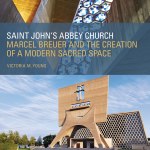"This book should be required reading in every architecture school.": ArchNewsNow review of 'Saint John's Abbey Church'
 In Theology in Stone: Church Architecture from Byzantium to Berkeley, a valuable and largely solemn overview of sacred architecture penned by Richard Kieckhefer, the author permits himself one lighthearted moment. Playing with the title of Tom Wolfe’s From Bauhaus to Our House, Kieckhefer’s jests that someone should write a book on Modernism’s impact on sacred architecture entitled, “From Bauhaus to God’s House.”
In Theology in Stone: Church Architecture from Byzantium to Berkeley, a valuable and largely solemn overview of sacred architecture penned by Richard Kieckhefer, the author permits himself one lighthearted moment. Playing with the title of Tom Wolfe’s From Bauhaus to Our House, Kieckhefer’s jests that someone should write a book on Modernism’s impact on sacred architecture entitled, “From Bauhaus to God’s House.”
Uncannily, that is precisely what professor of modern architectural history Victoria M. Young has done in Saint John’s Abbey Church: Marcel Breuer and the Creation of a Modern Sacred Space (University of Minnesota Press, 2014), a towering history of Breuer’s Bauhaus-influenced design of the church. One can only regret that Young’s book is saddled with an academically dry title with none of Kieckhefer’s or Wolfe’s wit. But that is easily overlooked when considering how Young’s book dazzles as an illuminating story of a critical episode in church architectural history, replete with lessons for architects in the present.
Here are the essential elements of Young’s story. The brethren at the Benedictine Abbey of Saint John the Baptist in Collegeville , Minnesota, during the 1950s seek to expand their campus. The impetus for this expansion? A desire to have their campus mirror changes in the Catholic liturgy, the orders of devotion codified in speech, song, and lifestyle. The center of this expansion was a new church. In aligning with the liberalizing spirit of the Catholic Church of that era, the Benedictines (known historically for their hospitality to those outside of their fold as well as within the church) requested proposals from an impressive range of globally honored architects, some with previous church design experience, some not; some Catholic; some not religious at all. What cohered the list of would-be architects that included Richard Neutra, Eero Saarinen, Walter Gropius, and Marcel Breuer, was a thoroughgoing commitment to Modernism, the spirit of “make it new.” The choice by the Benedictines of Marcel Breuer was daring. Breuer’s background was centered in the Bauhaus. He had never designed a church – and was not a Catholic, so lacked familiarity through intimate contact with both Catholic liturgy and architecture.
Continue reading the review here.
By: Norman Weinstein
Story Date: 2014-12-19T05:51:00+00:00



